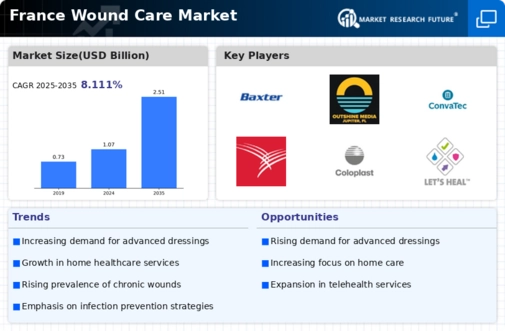Increasing Incidence of Chronic Wounds
The rising prevalence of chronic wounds, such as diabetic ulcers and pressure sores, is a notable driver in the wound care market. In France, the aging population contributes significantly to this trend, as older individuals are more susceptible to chronic conditions that lead to wounds. According to recent statistics, approximately 1.5 million people in France suffer from chronic wounds, which necessitates advanced wound care solutions. This growing patient population is likely to increase the demand for specialized wound care products and services, thereby propelling the wound care market forward. The healthcare system's focus on improving patient outcomes and reducing hospital stays further emphasizes the need for effective wound management strategies, indicating a robust growth trajectory for the wound care market in the coming years.
Shift Towards Home Healthcare Solutions
The shift towards home healthcare is reshaping the wound care market in France. Patients increasingly prefer receiving care in the comfort of their homes, which has led to a surge in demand for home-based wound care products and services. This shift is driven by the desire for personalized care, reduced healthcare costs, and improved patient satisfaction. In 2025, it is estimated that the home healthcare market in France will reach €10 billion, with a significant portion attributed to wound care solutions. As healthcare providers adapt to this trend, they are likely to invest in innovative products that facilitate effective wound management at home, thus expanding the wound care market's reach and accessibility.
Rising Awareness of Wound Care Management
There is a growing awareness regarding the importance of effective wound care management among both healthcare professionals and patients in France. Educational initiatives and campaigns aimed at promoting best practices in wound care are becoming more prevalent. This increased awareness is likely to lead to higher demand for advanced wound care products, as patients and providers recognize the benefits of timely and appropriate treatment. The wound care market is expected to grow by approximately 7% annually as a result of this heightened awareness. Furthermore, healthcare institutions are increasingly prioritizing wound care training for their staff, which may enhance the overall quality of care and further stimulate market growth.
Government Initiatives and Funding for Wound Care
Government initiatives aimed at improving healthcare infrastructure and funding for wound care services are emerging as a significant driver in the wound care market. In France, The government has allocated substantial resources to enhance wound care management, particularly in hospitals and community health settings. This funding is likely to facilitate the adoption of advanced wound care technologies and training programs for healthcare professionals. As a result, the wound care market is expected to benefit from increased accessibility to high-quality care and resources. The government's commitment to improving patient outcomes and reducing healthcare costs may further stimulate growth in the wound care market, positioning it for a robust expansion in the coming years.
Technological Advancements in Wound Care Products
Technological advancements are playing a crucial role in shaping the wound care market. Innovations such as bioengineered skin substitutes, smart dressings, and telemedicine solutions are enhancing the effectiveness of wound management. In France, the introduction of these advanced technologies is expected to drive market growth, as they offer improved healing rates and patient outcomes. The market for advanced wound care products is projected to reach €1.2 billion by 2026, reflecting a compound annual growth rate of 8%. These innovations not only improve the efficiency of wound care but also reduce the overall burden on healthcare systems, indicating a promising future for the wound care market.


















Leave a Comment